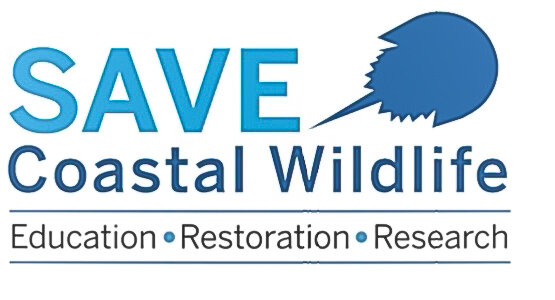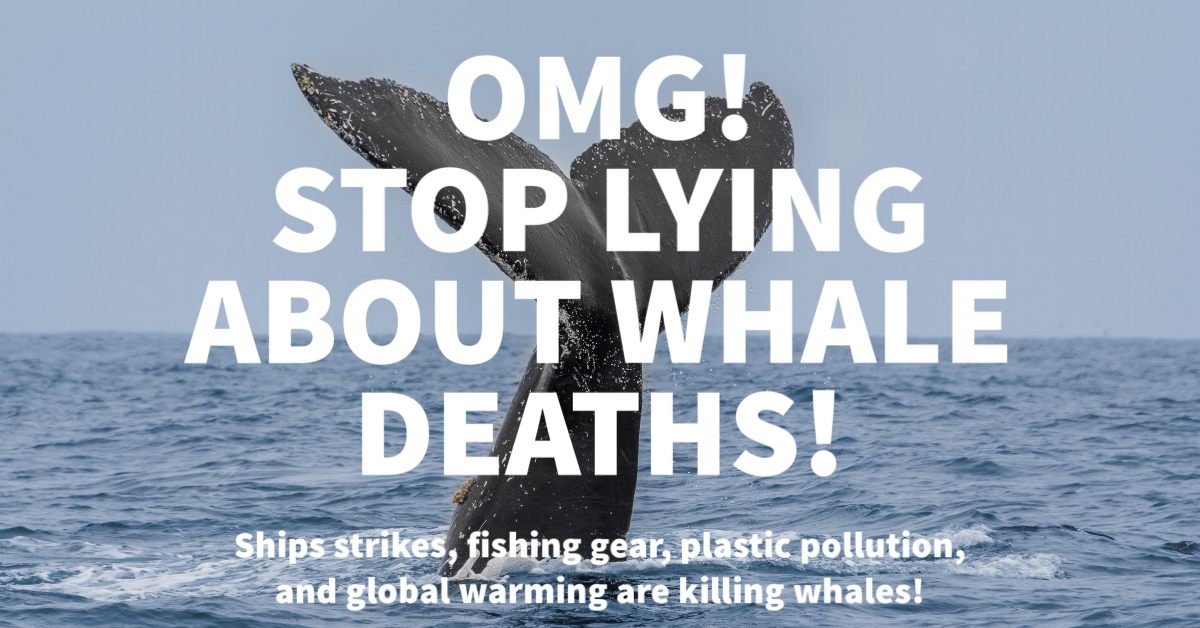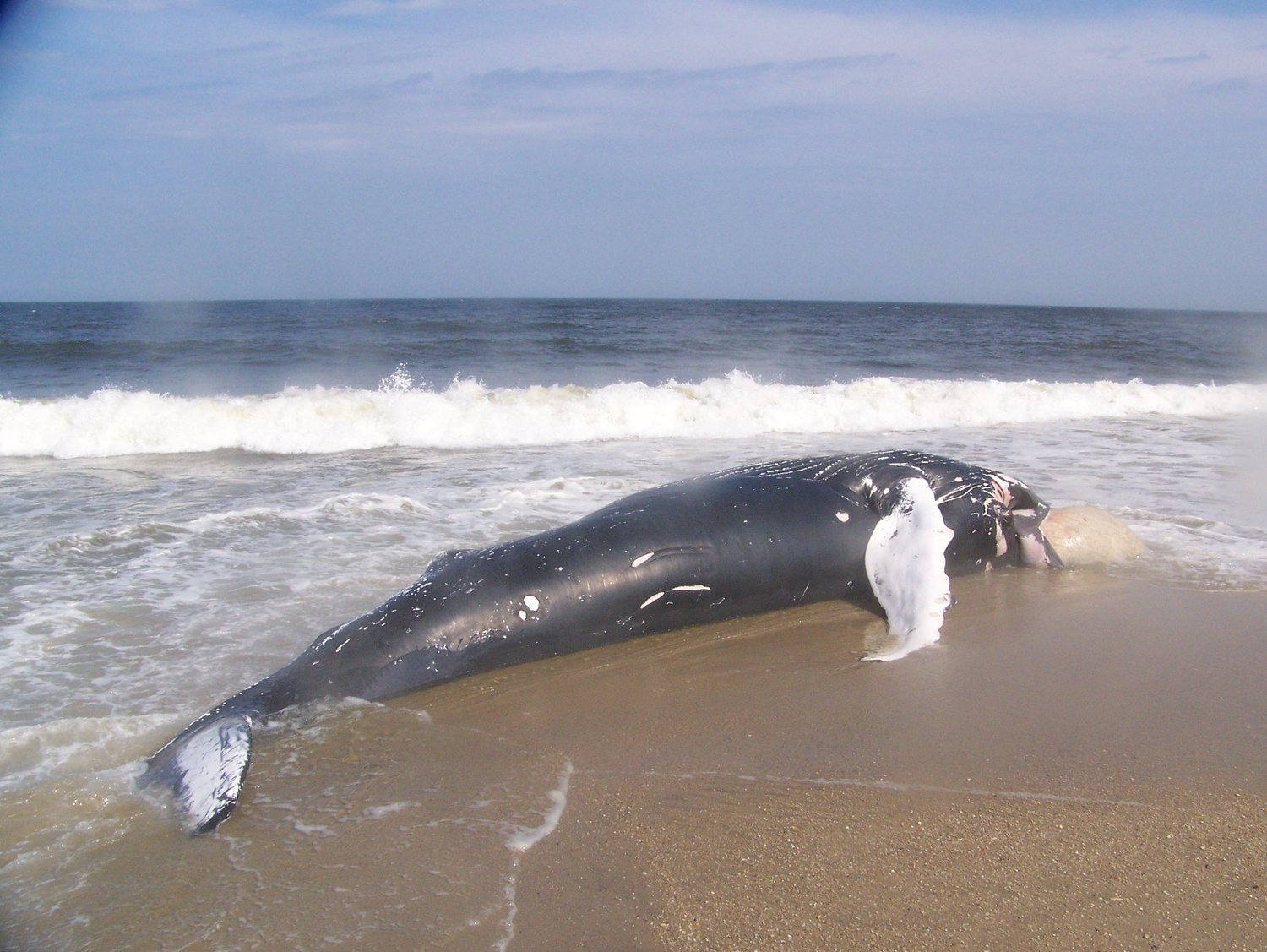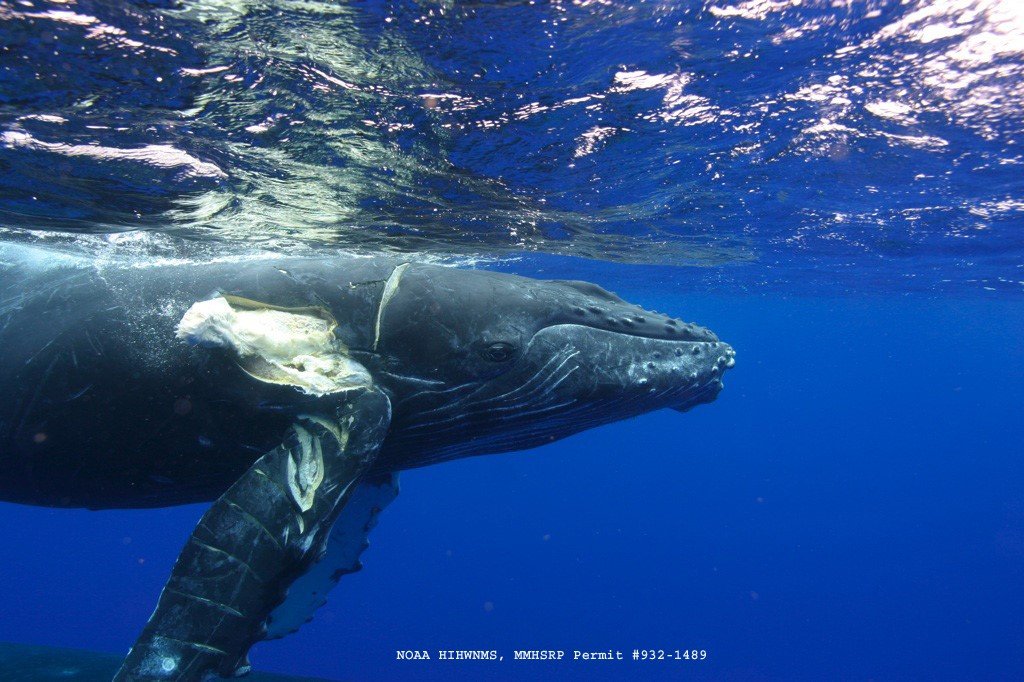STOP LYING ABOUT WHALE DEATHS
By Jenna Reynolds
President/Director
Save Coastal Wildlife Nonprofit
We are so sick of the lies, false knowledge and yellow journalism being spread by numerous people in the media (both social media and mainstream media) about the death of marine mammals along the Jersey Shore!
We love whales and all life in the ocean so much. We hate to see them disrespected, even when deceased. In particular, we dislike all the pictures of dead whales being politized and propagandized for personal gain. Imagine if they were pictures of recently deceased people, this would certainly not be tolerated. You would then understand how we feel.
Absolutely no proof exists, no evidence, no data, no documentation, not even inside tipoffs or traces, nothing at all to suggest offshore wind turbines and their development in the Atlantic Ocean is the cause of death for recently washed-up whales and dolphins in New Jersey or New York. All this nonsense takes away from what is truly destroying the whale population and other marine mammals.
Don’t be fooled by the media. There is an active campaign by many party-political and wealthy people, some of whom are connected with the fossil fuel industry, to try to kill the offshore wind industry in North America by any means necessary. There is a lot of documentation to back up this statement (click online links directly below).
How Did a Viral Story about Whales Go So Wrong?
The Man Trying to Kill America's Offshore Wind Industry.
Fossil fuel industry dupes media, quietly funds non-profits to block renewable energy
The fossil fuel industry’s deceptive campaign to kill offshore wind
U.S. fishing industry teams up with oil lobby to fight offshore wind
They aren't used to losing’: wealthy New York enclave battles over offshore windfarm
Fox News is rapidly escalating its anti-offshore wind campaign
Fox News' Jesse Watters fails to disguise oil-industry funded group as a grassroots “ocean advocate” organization
Growing group of mayors at odds with experts over whale deaths and offshore windmills
So, if not offshore wind, what activities are likely killing whales and other marine mammals along the Jersey Shore?
For starters, we need to appreciate the science behind the information. People have difficulty communicating with wildlife, including whales, so we need to follow the science and statistics to find out what is causing animals to pass away. For those people who distrust science, I ask a simple question. What would you do if you had a sick family member who was severely disabled and unable to communicate? Would you want your doctor to guess or imagine what is wrong? Instead, you may prefer your doctor to use scientific methods and technology to find out with a high probability what is causing your family member to be sick.
There is a tremendous amount of scientific evidence, data and documentation to show that whales and other marine mammals are being killed, injured, weakened and wounded by ship strikes, commercial fishing gear, plastic pollution, and global warming.
These factors are slaying and stressing out marine mammals along the Jersey Shore. But it’s issues that several people on social media and in the mainstream media are ignoring at the detriment of the health for whales, dolphins, seals and other amazing and beautiful biodiversity in the ocean. Instead, some in the media select to spread false knowledge, which we know from George Bernard Shaw is more dangerous than ignorance.
Here is what we understand for sure:
In August 2022, researchers at Gotham Whale, a nonprofit citizen-science organization that tracks whale populations around New York Harbor, indicated they spotted more than 260 whales (mostly juvenile humpback whales) in the New York City area so far that year. A decade ago, it was just five whales. It was the most whales they had seen in generations around New York Harbor.
Additionally, in July 2022, a study co-authored by Rutgers University, Gotham Whale, the Center for Coastal Studies and 21 other organizations in the western North Atlantic, found that 58.4 percent of whales spotted in the New York Bight Apex (NYBA) – the coastal area between Long Island and the New Jersey coast – between 2011-2018 were seen more than once, either within the same year or between years. The average length of stay was 37.6 days. The results suggest humpback whales exhibit extended occupancy in the NYBA – specifically the area extending east to Fire Island, New York and south to Manasquan Inlet, New Jersey and included the New York-New Jersey harbor estuary – and were likely to return from one year to the next (a 31.3 percent average).
This means the numbers of humpback and other species of whales in New York and New Jersey waters have grown and are staying longer over the past decade thanks, in part, to cleaner waters and increasing amounts of smaller bait fish, including menhaden or bunker. Humpback whales have become a year-round resident in New York and New Jersey waters in the last decade as they feed in the area for longer periods of time and return for consecutive years.
Yet, largely forgotten in the report was a statement by Danielle Brown, a doctoral candidate in the Ecology, Evolution and Natural Resources Department at Rutgers-New Brunswick and lead researcher for the non-profit Gotham Whale. In the report she stated:
“This research is important for the management of these protected species. The more time these whales spend in the New York Bight apex may mean increased exposure to human activities including busy shipping traffic leading into the Port of New York and New Jersey.”
As luck would have it, at the same time as the whale population is expanding in the area, so too is ship traffic.
On beaches around the New York Bight, there have been more than 62 reported mortalities of humpback whales between 2016 and early 2023, with many showing sign of death from a ship strike. Additionally, between 2017 and 2023 in New York and New Jersey, ship strikes killed or injured over 15 North Atlantic right whales.
A JUVENILE HUMPBACK WHALE WASHED UP DEAD ALONG MONMOUTH BEACH, NJ IN 2009 SOON AFTER BEING STRUCK BY A CARGO SHIP IN THE ATLANTIC OCEAN.
If you look closely, you will see the stomach of the animal sticking out of its mouth due to the strong impact of the ship strike.
Around 45% of whale sightings recorded by Gotham Whale were less than 3 kilometers (1.8 miles) from shore. Analysis of automatic identification system data from passing vessel traffic also showed that in 2016, 95% of sightings were within 100 meters (328 feet) of at least one vessel in transit.
Ship traffic has increased more than 34 percent in the last 5 years. It doubles every ten years, putting under pressure the entire ecosystem where whales travel and feed. Worse still, modern vessels have augmented (sped up) their speed, making it more difficult to avoid a strike if, by chance, ships can spot a whale in their path, which doesn’t happen often. According to research carried out by non-profit Friends of the Sea, ship strikes kill more than 20,000 whales every year globally. This is nearly 55 whales every day.
A pair of screen shots. One showing the sightings of whales that were reported on February 9, 2023 (left) and the second showing the amount of ship traffic on the same day (right).
Current shipping rules focus on a patchwork of slow zones that require mariners to slow down for whales, but some of the zones are mandatory, while others are voluntary. In 2021, Oceana released a report that said noncompliance was as high as nearly 90% in voluntary zones and was also dangerously low in the mandatory ones.
Why are there so many ships off the coast of New Jersey?
Over 26 million people living in New York City, New Jersey and Long Island (that’s like the entire population of Australia within a small corner of the East Coast).
There are over 26 million people living in New York City, New Jersey and Long Island (that’s like the entire population of Australia within a small corner of the East Coast). With that many consumers, it is no wonder the Atlantic Ocean is one of the busiest international maritime trade (shipping) routes in the world. There are large ships coming and going all the time.
The Port of New York and New Jersey is ranked as the busiest port in the United States. The port first overtook the Port of Los Angeles as the nation’s busiest port in August 2022 and has maintained its lead ever since. The Port of New York and New Jersey is also the largest port on the East Coast of the United States. Moreover, the Port of Philadelphia is one of the largest shipping areas of the United States. In 2016, 2,427 ships arrived at Delaware River port facilities. Our ocean waters along the Jersey Shore are not a pristine wilderness, but a busy and bustling urban jungle that never sleeps with ship traffic.
Commercial cargo ships and tankers can move very close to the coast where whales sometimes feed. This picture was taken at Sandy Hook, Gateway National Recreation Area, North Beach, at the entrance to New York Harbor during August 2019.
Another major threat facing our marine ecosystem today, including marine mammals, is climate change. Recent studies suggest one reason for the recent rise in humpback whale sightings along the Jersey Shore is climate change, which could influence where humpback whales spend their time. Farther north on their traditional feeding grounds, like the Gulf of Maine, the waters are warming very quickly, which may affect fish and plankton populations.
In 2022, the Gulf of Maine Research Institute announced the warmth of inlet waters adjacent to Maine and northern Massachusetts was the highest on record between September and November — nearly 0.5 degrees warmer than 2012, which previously held the title for warmest fall. Sea surface temperatures during the season hovered above 60 degrees through almost the end of October, about 6 degrees above normal.
Increasing amounts of greenhouse gases released from the burning of fossil fuels is causing the temperature of the North Atlantic Ocean, where whales reside to feed, to get much hotter. According to a 2021 study published in Oceanography, warmer ocean waters have killed off or significantly decreased plankton populations that North Atlantic right whales depend on to forage for food. As a result, the whales have abandoned traditional feeding grounds along New England to migrate further into areas of which are used heavily for commercial fishing activities.
Scientific studies have also found that climate change may be a factor in recent whale deaths along other parts of the East Coast. Recent studies have shown that oceanic fossil fuel drilling plus oil spills have killed large quantities of whales within the Gulf of Mexico.
Still another major threat to the life of marine mammals is plastic pollution. In July 2022, the International Marine Mammal Project (IMMP), a project of Earth Island Institute, released a report detailing the harmful impacts of plastics on marine mammals. The study found plastic pollution and fishing gear to be the leading threat to marine mammals, killing more than 300,000 dolphins, porpoises, and small whales every year, not to mention other species.
In May 2022, a male sperm whale that was 47-feet in length died off the Florida Keys. A necropsy found a mass of intertwined plastic fishing line, pieces of plastic fishing nets, and plastic bags in the whale’s stomach. This debris likely interfered with the whale’s ability to digest food and absorb nutrition. Furthermore, in 2020, researchers examined seven beluga whales harvested by Inuvialuit hunters in northern Canada. Their study found microplastics in the digestive systems of every whale. There is no doubt that our ocean and coastal waters are filling up with plastic, which in turn is filling up the stomachs of whales and other creatures in the sea.
Another thing to worry about is avian flu. Although it mainly affects birds, avian influenza, or bird flu, can be transmitted to mammals, including marine mammals. For example, in March 2022, the death of a dolphin in the Gulf of Mexico was attributed to bird flu, which triggered inflammation of the brain. A few months later in June 2022, the first case of a porpoise to succumb to avian influenza was documented in Sweden. It is likely that this porpoise had come into contact with infected wild birds. Could avian flu impact our local dolphin population? Certainly, more research needs to be done, but I would be worried about people getting too close to stranded dead animals.
All combined, there are many, many threats putting great stress on our marine mammal population along the Jersey Shore. This in turn is shrinking populations of whale species by reducing their breeding rate, thus slowing the rate of population replacement. This is particularly true for the North Atlantic right whale, which feeds and migrates along the Jersey Shore and is one of the most endangered whale species in the world. The latest preliminary estimate suggests there are fewer than 350 individual North Atlantic right whales in the world and out of this number only around 70 are reproductive females. If nothing is done to protect North Atlantic right whales, they will likely disappear and go extinct.
As for offshore wind, so far there are two pilot wind projects that operate in the Atlantic Ocean: Dominion’s two turbines off Virginia Beach and Orsted’s five-turbine wind farm off Rhode Island. After the United States’ first offshore turbines were built off the Virginia Beach coast in 2020, local media reported that the wind towers’ metal foundations provided a source of “artificial reefs” for schools of fish, algae, sea turtles, and more. Other wind apparatuses off the coasts of Taiwan serve as safe habitats for coral species, allowing the embattled oceanic plant a chance to repopulate.
Additionally, studies in 2006 along the coast of Germany and Denmark found that noise involved in turbine development—including echolocation for initial ocean-population surveying, pile-driving for turbine establishment, and the actual spinning of rotor blades—did not harm marine mammals’ auditory organs. The countries did find, however, that sound from the construction process could affect whales’ general behavior, in that they avoid swimming near noisier areas. Offshore wind turbines are currently located over quite a few European coastlines, with the main European Union producers of offshore wind energy being Germany, the Netherlands, Belgium and Denmark. There is no evidence to suggest any marine mammals are being harmed in these areas of the world.
There is no evidence that offshore wind projects are to blame for the whale deaths. The type of sound imaging used by the wind industry is likely outside the presumed hearing range of humpbacks, said Erica Staaterman, a marine acoustics expert with the Bureau of Ocean Energy Management (BOEM), which oversees the leasing of offshore energy resources. The sounds are also far quieter than those emitted during oil and gas exploration, which employs “air guns” to map deep beneath the sea floor.
When the evidence changes, so will our thinking. That is the beauty of science, it is always everchanging when new information arises. Otherwise, blaming something that has no grounds of support is unethical and wanton.
No doubt going forward offshore wind developers will need to exercise extreme care and caution to reduce the risk of wildlife disruption and disturbance. After all, just because wind power has no ties to whale deaths doesn’t mean there are zero harmful impacts. Any type of development is going to pose risks to the environment, and ocean life is already struggling due to shipping traffic, climate change, plastic pollution and many other environmental problems. A March 5, 2019 blog written by Priscilla Brooks for the Conservation Law Foundation outlined several ways that offshore wind turbines and whales can live together.
People have the absolute right to be against offshore wind and other forms of renewable energy, and to believe what they want to believe. We don’t have a problem when people disagree with us. In fact, we respect the right for people to have their own opinions. We have always appreciated a diversity of thoughts and ideas. But we don’t care or appreciate the half-truths and misrepresentation of whales and other marine life in people’s political or propaganda games and the continuing use of false knowledge. Please respect wildlife!
If you wish to save whales along the Jersey Shore then we need to work together, not separately.
What can you do:
Please sign our petition to urge the National Oceanic and Atmospheric Administration (NOAA) to quickly put in place their proposed rules designed to prevent ships from colliding with whales.
The federal government wants the shipping industry to take more responsibility to protect whales, but as of yet there is no timeframe for when proposed rules will be adopted or go into effect. Yet with more whales washing up dead on beaches along the East Coast in 2022 and 2023, the time is now!
Proposed new rules would expand seasonal slow zones off the East Coast that require ships to slow down to 10 knots (11.5 miles per hour). They would also require more vessels to comply with the rules by expanding the size classes that must slow down to 35 feet and longer from the current threshold at 65 feet and longer. It would also expand existing “slow zones” in the Atlantic Ocean to as far as 100 miles offshore. Furthermore, the rules would create a framework to implement mandatory speed restrictions when whales are known to be present outside the seasonal slow zones.
In addition, please contact your U.S. federal senators and congresspeople in Washington D.C. to urge them to put pressure on NOAA to install right away mandatory slow zones along the East Coast of the United States.
Humpback whale that has been injured from ship propellors. Picture from the International Whaling Commission












